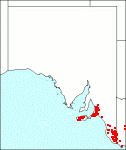Family: Ericaceae
Epacris impressa
Citation:
Labill., Nov. Holl. Pl. Sp. 1:43, t. 58 (1805).
Synonymy: Epacris ceriflora Common name: (Common) heath.
Description:
Erect shrub 20-120 cm high; young branches red, fibbed, densely tomentose; leaves spreading, linear-lanceolate to ovate-lanceolate, 4-13 mm long, 1-2.9 mm wide, acute to acuminate with a mucronate tip to 0.8 mm, base truncate, margins straight, unthickened, sparsely puberulent, lamina thin, flat, with the midrib thickened abaxially and often puberulent, venation otherwise inconspicuous; sessile.
Flowers white, pink or red, often pendulous; peduncles to 2.5 mm long, pubescent; bracts triangular to ovate, 1.1-4 x 0.7-1.5 ram, glabrous except for ciliate margins; sepals pale, often pink-tinged, elliptic-ovate, usually acute, 2-5.1 x 1.2-1.7 mm, ciliolate; corolla tube cylindrical, 6-18 mm long, with 5 small invaginations near the base immediately above the ovary and alternating with the stamens; lobes 1.9-3.8 mm long, obtuse, erect to spreading, with cordate overlapping bases; anthers red to orange, 1.1-2 mm long; ovary 1-1.4 x 1.3-1.6 mm; style 7.4-16.5 mm long, slender; stigma capitate, exserted; nectary scales c. 0.4 mm high, obtuse.
Fruit green, 3.3-3.5 x 3.4-3.6 mm, usually just exceeding the sepals, globular to flat-topped, style persistent, with many seeds per cell.
|
|
Distribution:
|
Occurs in scrub and heathland, occasionally in swampy areas on sandy soils.
S.Aust.: SL, KI, SE. N.S.W.; Vic.; Tas.
|
Conservation status:
native
Flowering time: April — Aug.; fruit: Nov. — Dec.
|

SA Distribution Map based
on current data relating to
specimens held in the
State Herbarium of South Australia
|
Biology:
No text
Taxonomic notes:
A polymorphic species, the plants varying in the colour and size of the flowers and in the shape and size of the leaves. Stace and Fripp (1977) Aust. J. Bot. 25:299-336 suggest that 4 forms or races exist; they distinguish those with short white corollas, long pink and long red corollas, and a campanulate form, (= var. grandifiora Benth.), found in the Victorian Grampians.
Author:
Not yet available
|

